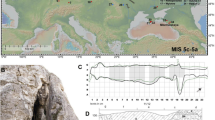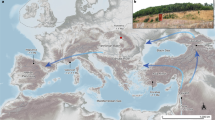Abstract
The late survival of archaic hominin populations and their long contemporaneity with modern humans is now clear for southeast Asia1. In Europe the extinction of the Neanderthals, firmly associated with Mousterian technology, has received much attention, and evidence of their survival after 35 kyr bp has recently been put in doubt2. Here we present data, based on a high-resolution record of human occupation from Gorham’s Cave, Gibraltar, that establish the survival of a population of Neanderthals to 28 kyr bp. These Neanderthals survived in the southernmost point of Europe, within a particular physiographic context, and are the last currently recorded anywhere. Our results show that the Neanderthals survived in isolated refuges well after the arrival of modern humans in Europe.
This is a preview of subscription content, access via your institution
Access options
Subscribe to this journal
Receive 51 print issues and online access
$199.00 per year
only $3.90 per issue
Buy this article
- Purchase on Springer Link
- Instant access to full article PDF
Prices may be subject to local taxes which are calculated during checkout

Similar content being viewed by others
References
Brown, P. et al. A new small-bodied hominin from the Late Pleistocene of Flores, Indonesia. Nature 431, 1055–1061 (2004)
Mellars, P. A. A new radiocarbon revolution and the dispersal of modern humans in Eurasia. Nature 439, 931–935 (2006)
Busk, G. On a very ancient cranium from Gibraltar. Report of the 34th Meeting of the British Association for the Advancement of Science (Bath, 1864) 91–92 (1865)
Garrod, D. A. E., Buxton, L. H. D., Elliot Smith, G. & Bate, D. M. A. Excavation of a Mousterian Rock-shelter at Devil’s Tower, Gibraltar. J. R. Anthropol. Inst. 58, 91–113 (1928)
Mellars, P. The Neanderthal Legacy (Princeton Univ. Press, Princeton, 1996)
Waechter, J. D’A. The excavations at Gorham’s Cave, Gibraltar, 1951–1954. Bull. Inst. Archaeol. Lond. 4, 189–221 (1964)
Barton, N. in Neanderthals on the Edge (eds Stringer, C. B., Barton, R. N. E. & Finlayson, C.) 211–220 (Oxbow Books, Oxford, 2000)
Pettitt, P. B. & Bailey, R. M. in Neanderthals on the Edge (eds Stringer, C. B., Barton, R. N. E. & Finlayson, C.) 155–162 (Oxbow Books, Oxford, 2000)
Reimer, P. J. et al. Comment on ‘Radiocarbon calibration curve spanning 0 to 50,000 years BP based on paired 230Th/234U/238U and 14C dates on pristine corals’ by R. G. Fairbanks et al. (Quaternary Science Reviews 24 (2005) 1781–1796) and ‘Extending the radiocarbon calibration beyond 26,000 years before present using fossil corals’ by T.-C. Chin et al. (Quaternary Science Reviews 24 (2005) 1797–1808). Quat. Sci. Rev. 25, 855–862 (2006)
Romano, F. P. et al. Quantitative non-destructive determination of trace elements in archaeological pottery using a portable beam stability-controlled XRF spectrometer. XRay Spectrom. 35, 1–7 (2006)
Gaudzinski, S. (2004) A matter of high resolution? The Eemian Interglacial (OIS 5e) in North-central Europe and Middle Palaeolithic subsistence. Int. J. Osteoarchaeol. 14, 201–211 (2004)
Grayson, D. K. & Delpech, F. Ungulates and the Middle-to-Upper Paleolithic transition at Grotte XVI (Dordogne, France). J. Archaeol. Sci. 30, 1633–1648 (2003)
Higham, T. F. G., Jacobi, R. M. & Bronk Ramsay, C. AMS radiocarbon dating of ancient bone using ultrafiltration. Radiocarbon 48, 179–195 (2006)
Higham, T., Bronk Ramsey, C., Karavanic, I., Smith, F. H. & Trinkaus, E. Revised direct radiocarbon dating of the Vindija G1 Upper Palaeolithic Neanderthals. Proc. Natl Acad. Sci. USA 103, 553–557 (2006)
Barroso Ruiz, C. (ed.) El Pleistoceno Superior de la Cueva del Boquete de Zafarraya (Junta de Andalucía, Arqueología Monografías, 2003)
Skinner, A. R. et al. ESR dating at Mezmaiskaya Cave, Russia. Appl. Radiat. Isot. 62, 219–224 (2005)
Zilhao, J. in Neanderthals on the Edge (eds Stringer, C. B., Barton, R. N. E. & Finlayson, C.) 111–119 (Oxbow Books, Oxford, 2000)
Finlayson, C. Biogeography and evolution of the genus Homo.. Trends Ecol. Evol. 20, 457–463 (2005)
d’Errico, F. & Sánchez Goñi, M. F. Neanderthal extinction and the millennial scale climatic variability of OIS 3. Quat. Sci. Rev 22, 769–788 (2003)
Finlayson, C. Neanderthals and Modern Humans (Cambridge Univ. Press, Cambridge, 2004)
Mellars, P. The Neanderthal problem continued. Curr. Anthropol. 40, 341–364 (1999)
Kirsch, H. J. Illite crystalinity: recommendations on sample preparation, X-ray diffraction settings, and interlaboratory samples. J. Metamorphic Geol. 9, 665–670 (1991)
Martin, J. D. Qualitative and quantitative powder X-ray diffraction analysis. <http://www.xpowder.com> (2004)
Sakamoto, T. et al. 2006 non-destructive X-ray fluorescence (XRF) core imaging scanner, ‘TATSCAN-F2’ for the IODP science, scientific drilling. Integrated ODP 2, 37–39 (2006)
Bea, F., Montero, P., Stroh, A. & Baasner, J. Microanalysis of minerals by an Excimer UV-LA-ICP-MS system. Chem. Geol. 133, 145–156 (1996)
Acknowledgements
We thank all those who have participated in this project. The project Palaeomed was co-funded by the Government of Gibraltar and the European Union Interreg IIIB Programme Medocc. Palynological and geochemical investigations were funded by Fundación Séneca, Murcia, Spain, and Ministerio de Educación y Ciencia, DGI, Spain, respectively. Geomorphological work was funded by Ministerio de Educación y Ciencia, DGI, Spain. Author Contributions C.F., F.G.P., J.R.-V. and C.B.S. were responsible for project direction and management. C.F. coordinated the writing. Multidisciplinary work was divided as follows: archaeology and curation—F.G.P., J.M.G.L., A.S.P., J.B.P., F.G.G., K.B., C.A.V. and A.V.; geomorphology and sedimentology—J.R.-V., F.J.J.E., F.M.R. and T.S.; taphonomy—I.C. and Y.F.J.; palaeoecology—C.F., D.A.F. (general), G.F. (palaeolandscape), E.A. (anthracology), J.S.C., P.L., J.A.L.S., N.F. (palaeobotany), C.P.G.-O. (herpetological taxonomy), J.A.R.C. (mammalian taxonomy) and A.S.M. (avian taxonomy). All authors discussed and interpreted the results and commented on the manuscript.
Author information
Authors and Affiliations
Corresponding author
Ethics declarations
Competing interests
Reprints and permissions information is available at www.nature.com/reprints. The authors declare no competing financial interests.
Supplementary information
Supplementary Notes
This file contains Supplementary Notes under five headings: 1. Stratigraphic and archaeological information for Levels III and IV Gorham’s Cave, Gibraltar (including 2 Supplementary Figures); 2. Geochemical and Mineralogical Analyses (including 2 Supplementary Tables and 2 Supplementary Figures.); 3. Taphonomy (1 Supplementary Table); 4. AMS Dating; and 5. Ecology (1 Supplementary Table). (DOC 10175 kb)
Rights and permissions
About this article
Cite this article
Finlayson, C., Giles Pacheco, F., Rodríguez-Vidal, J. et al. Late survival of Neanderthals at the southernmost extreme of Europe. Nature 443, 850–853 (2006). https://doi.org/10.1038/nature05195
Received:
Accepted:
Published:
Issue Date:
DOI: https://doi.org/10.1038/nature05195
This article is cited by
-
Valdeprovedo open-air site: a knapping event in the early Upper Paleolithic of the Sierra de Atapuerca (Burgos, Spain)
Archaeological and Anthropological Sciences (2024)
-
The Middle Paleolithic of the Balkans: Industrial Variability, Human Biogeography, and Neanderthal Demise
Journal of World Prehistory (2023)
-
First Data from the Prehistoric Site Complex of Cueva del Arco (Murcia, Spain)
Journal of Paleolithic Archaeology (2023)
-
New insights in Neanderthal palaeoecology using stable oxygen isotopes preserved in small mammals as palaeoclimatic tracers in Teixoneres Cave (Moià, northeastern Iberia)
Archaeological and Anthropological Sciences (2022)
-
Lithic technological choices of late Neandertals in a mountain environment south of the Ebro Valley, Iberian Peninsula (Peña Miel level e)
Archaeological and Anthropological Sciences (2021)
Comments
By submitting a comment you agree to abide by our Terms and Community Guidelines. If you find something abusive or that does not comply with our terms or guidelines please flag it as inappropriate.



